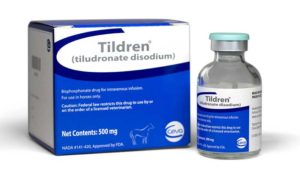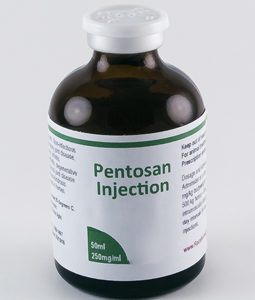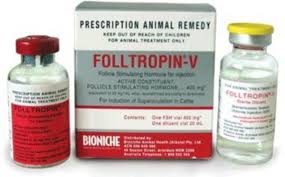(tiludronate disodium)
This page contains information on Tildren (tiludronate disodium) for veterinary use.
The information provided typically includes the following:
- Tildren (tiludronate disodium) Indications
- Warnings and cautions for Tildren (tiludronate disodium)
- Direction and dosage information for (tiludronate disodium)
Tildren (tiludronate disodium)
This treatment applies to the following species:
- Horses
- Manufacturer: Ceva Animal Health
Bisphosphonate drug for intravenous infusion.
For use in horses only.
Caution: Federal law restricts this drug to use by or on the order of a licensed veterinarian.
Description
Its United States Adopted Name (USAN) is tiludronate disodium. Tiludronate disodium is the hydrated hemihydrate form of the disodium salt of tiludronic acid. Its chemical name is [[(4-Chlorophenyl) thio]methylene] bis[phosphonic acid], disodium salt, and its structural formula is as follows:
DOSAGE AND ADMINISTRATION
Maximum effect may not occur until 2 months post-treatment.
DIRECTIONS FOR ADMINISTRATION
Do not reconstitute or mix TILDREN with calcium containing solutions or other solutions containing divalent cations such as Lactated Ringers as it may form complexes with these ions.
STEP 1: Preparation of the reconstituted solution (20 mg/mL). TILDREN should be reconstituted using strict aseptic technique. Remove 25 mL of solution from a 1 liter bag of sterile 0.9% Sodium Chloride Injection, USP and add it to one vial of TILDREN. This reconstituted solution contains 20 mg of tiludronate disodium per mL.
STEP 2: Preparation of the solution for infusion. Using strict aseptic technique, withdraw the appropriate volume of the reconstituted solution based on the horse’s body weight (see Table 1 below). Inject that volume back into the 1 liter bag of sterile 0.9% Sodium Chloride Injection, USP. Horses greater than 1,210 lbs. will require a second vial of reconstituted TILDREN solution. Invert the infusion bag to mix the solution before infusion. Label the infusion bag to ensure proper use.
STEP 3: Administer for infusion through a suitable intravenous catheter inserted into a jugular vein and connected to the infusion bag using sterile disposable infusion tubing.
Contraindications
Do not use in horses with known hypersensitivity to tiludronate disodium or to mannitol.
Do not use in horses with impaired renal function or with a history of renal disease.
WARNINGS
Do not use in horses intended for human consumption.
NSAIDs should not be used concurrently with TILDREN. Concurrent use of NSAIDs with TILDREN may increase the risk of renal toxicity and acute renal failure. Additionally, horses concurrently administered TILDREN and NSAIDs in field studies demonstrated a statistically significant increase in serum blood urea nitrogen (BUN) and creatinine concentrations.
HUMAN WARNINGS
Not for human use. Keep this and all drugs out of the reach of children. Consult a physician in case of accidental human exposure.
PRECAUTIONS
Approximately 30-45% of horses administered TILDREN will demonstrate transient signs consistent with abdominal pain (colic). Colic signs can last approximately 90 minutes and may be intermittent in nature. Hand-walking the horse may improve or resolve the colic signs in many cases. Avoid NSAID use. (See Warnings.)
TILDREN affects plasma concentrations of certain minerals and electrolytes, including calcium, magnesium and potassium, immediately post-treatment, with effects lasting up to several hours.
Horses with HYPP (heterozygous or homozygous) may be at an increased risk for adverse reactions, including colic signs, hyperkalemic episodes, and death. In one field study, one horse that was an unknown carrier (heterozygous) for HYPP died after receiving TILDREN. The safe use of TILDREN has not been evaluated in horses less than 4 years of age. The effect of bisphosphonates on the skeleton of growing horses has not been studied; however, bisphosphonates inhibit osteoclast activity which impacts bone turnover and may affect bone growth.
The extent of bisphosphonate incorporation into adult bone, and hence, the amount available for release back into the systemic circulation, is directly related to the total dose and duration of bisphosphonate use. Bisphosphonates have been shown to cause fetal developmental abnormalities in laboratory animals. The uptake of bisphosphonates into fetal bone may be greater than into maternal bone creating a possible risk for skeletal or other abnormalities in the fetus.
Increased bone fragility has been observed in laboratory animals treated with bisphosphonates at high doses or for long periods of time. Bisphosphonates inhibit bone resorption and decrease bone turnover which may lead to an inability to repair microdamage within the bone.
ADVERSE REACTIONS
Adverse reactions were most common during the infusion or within 4 hours following the end of the infusion (see Table 2). Fifty-seven TILDREN-treated horses (41%) and seven vehicle control horses (10%) exhibited at least one sign consistent with abdominal discomfort or colic (pawing, evidence of pawing, getting up and down, pacing, restlessness, rolling, trying to roll, looking at or biting at side, stretching out/straining, kicking at belly/walls, and shifting weight). Incidence of adverse reactions was similar to the controlled field effectiveness study.
Table 2: Number of Adverse Reactions in the Controlled Field Effectiveness Study and in the 6-month Open Use Field Study
TILDREN is a sterile powder. Each vial of TILDREN contains 500 mg of tiludronic acid (as tiludronate disodium) and 250 mg mannitol USP (excipient).INDICATION






Reviews
There are no reviews yet.